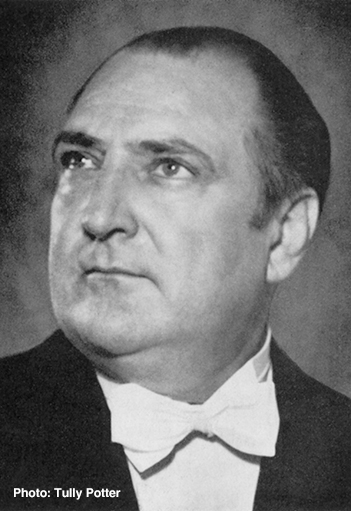Franz Konwitschny
The son of a conductor, Franz Konwitschny studied at the German Music Society School in Brno (1921–1923) and then at the Leipzig Conservatory (1923–1925). Having started his professional career as a violinist and violist playing in various orchestras, including the Leipzig Gewandhaus Orchestra under Furtwängler, he moved to Vienna in 1925, becoming the violist in the Fitzner String Quartet at the same time as teaching at the Volksconservatorium. He joined the Stuttgart Opera in 1927 as a répétiteur and quickly worked his way up to the position of first conductor (1930). After leaving Stuttgart in 1933 to become chief conductor at Freiburg, in 1938 he was appointed to the same position at the Frankfurt Opera, where in addition he had responsibility for the Museum Concerts.
Immediately after World War II Konwitschny was chief conductor at Hanover as well as a guest conductor at the Hamburg Opera (1946–1949); in 1949 he was appointed chief conductor of the Leipzig Gewandhaus and retained this post until his death. Between 1953 and 1955 he was also chief conductor at the Dresden Staatsoper and in 1955 succeeded Erich Kleiber as chief conductor of the newly restored Berlin Staatsoper. He conducted Wagner’s Ring cycle at the Royal Opera House, Covent Garden in 1959 to considerable acclaim, returning to London to work with the London Philharmonic Orchestra in 1961 and in the same year touring Japan with the Leipzig Gewandhaus Orchestra. Konwitschny died unexpectedly of a heart attack during a rehearsal of Beethoven’s Missa Solemnis while on tour in Yugoslavia and unusually for a musician he was awarded a full state funeral, including a Catholic requiem mass, by the East German political authorities. In tribute to him the Leipzig Gewandhaus Orchestra performed, conductorless, Beethoven’s Symphony No. 3 ‘Eroica’.
Equally at home in both the operatic and symphonic repertoires, Konwitschny left a considerable discography that is representative of his strengths as a conductor. His readings in both fields are extremely muscular and possess considerable vitality, with strongly contoured structural outlines allied to considerable intensity of expression. He was a conductor who evidently disliked rehearsals, and was happy to give orchestras their head, while being able to re-exert control at a moment’s notice: a sense of spontaneity as well as fire is present in many of his recordings. An outstanding Wagnerian, Konwitschny recorded complete accounts of both Der fliegende Holländer and Tannhäuser commercially for EMI, and a performance of Tristan und Isolde with the Leipzig Gewandhaus Orchestra that was one of the first complete recordings of a Wagner opera to be issued on long-playing records. He also conducted several LPs of orchestral excerpts from Wagner operas with the Bavarian State Opera and Czech Philharmonic Orchestras.
In the symphonic field Konwitschny recorded complete cycles of the Beethoven and Schumann symphonies with the Leipzig Gewandhaus which are characteristically vital; his account of Beethoven’s Symphony No. 7 was for some years a primary recommendation. His recording of Schubert’s Symphony No. 9 ‘Great C major’, is robust and vigorous, and a good example of his strengths as a conductor. An excellent interpreter of late-Romantic orchestral music, he recorded early long-playing record versions of Richard Strauss’s Eine Alpensinfonie (with the Bavarian State Opera Orchestra) and Symphonia domestica (with the Dresden Staatskapelle) as well as vital accounts of Don Juan, Till Eulenspiegels lustige Streiche and the Suite from Der Rosenkavalier (with the Vienna Symphony Orchestra). A noted Brucknerian, Konwitschny recorded a powerful reading of the Symphony No. 4 ‘Romantic’, as well as the Symphonies Nos 2, 5 and 7. He also conducted several distinguished concerto recordings, including the Violin Concerto and Piano Concerto No. 1 of Brahms with David Oistrakh and Wilhelm Kempff respectively for Deutsche Grammophon, and the Beethoven Violin Concerto with Josef Suk and the Czech Philharmonic Orchestra for the Supraphon label.
© Naxos Rights International Ltd. — David Patmore (A–Z of Conductors, Naxos 8.558087–90).

















